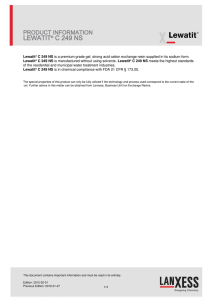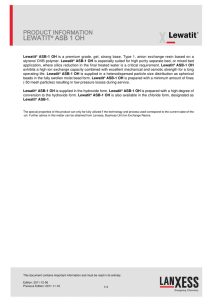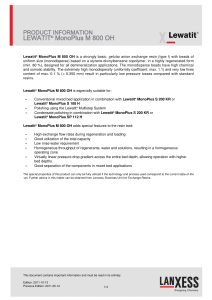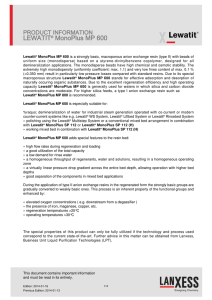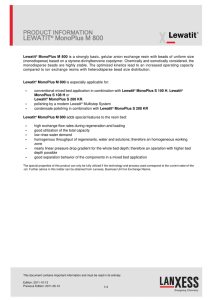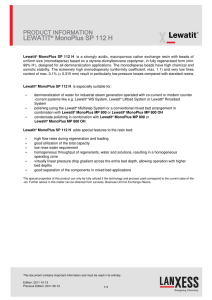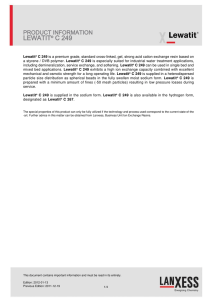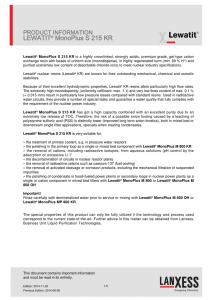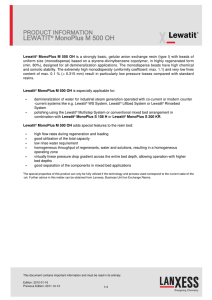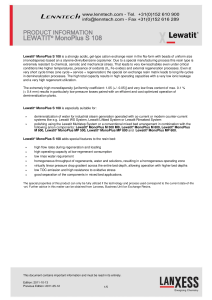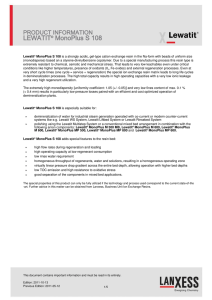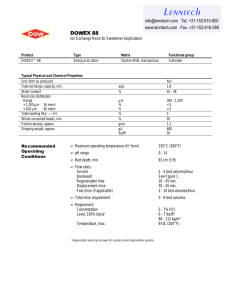condensate polishing system, with beads of uniform size (monodisperse) based... divinylbenzene copolymer, in fully regenerated form (min. 99% H Lewatit
advertisement
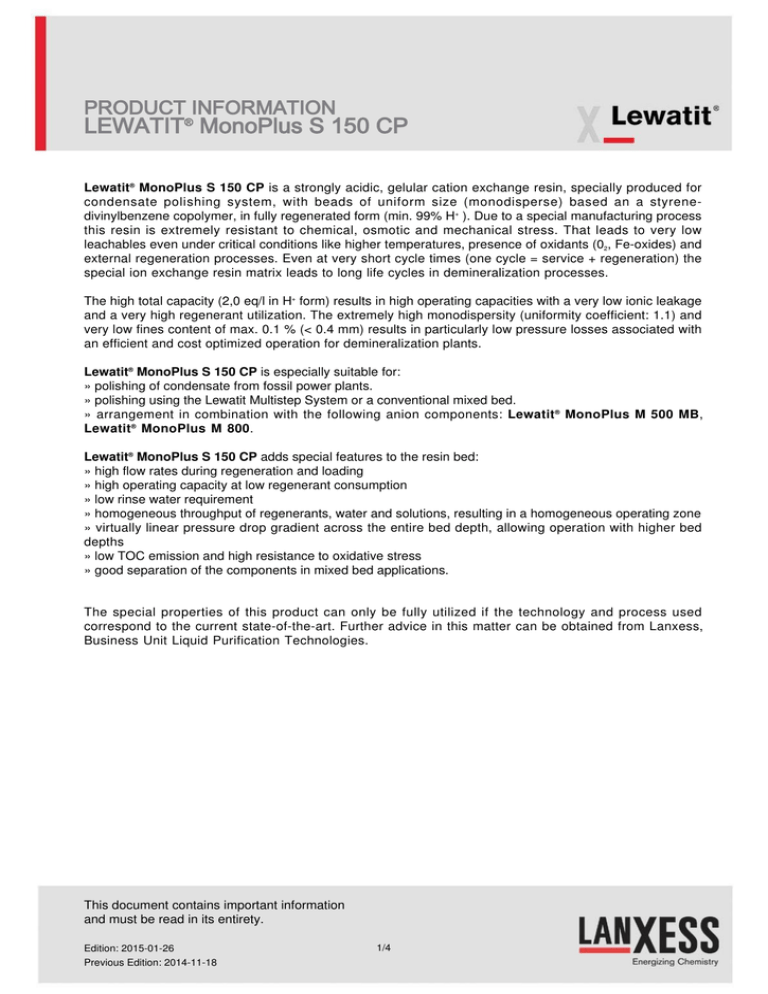
Lewatit® MonoPlus S 150 CP is a strongly acidic, gelular cation exchange resin, specially produced for condensate polishing system, with beads of uniform size (monodisperse) based an a styrenedivinylbenzene copolymer, in fully regenerated form (min. 99% H+ ). Due to a special manufacturing process this resin is extremely resistant to chemical, osmotic and mechanical stress. That leads to very low leachables even under critical conditions like higher temperatures, presence of oxidants (02, Fe-oxides) and external regeneration processes. Even at very short cycle times (one cycle = service + regeneration) the special ion exchange resin matrix leads to long life cycles in demineralization processes. The high total capacity (2,0 eq/l in H+ form) results in high operating capacities with a very low ionic leakage and a very high regenerant utilization. The extremely high monodispersity (uniformity coefficient: 1.1) and very low fines content of max. 0.1 % (< 0.4 mm) results in particularly low pressure losses associated with an efficient and cost optimized operation for demineralization plants. Lewatit® MonoPlus S 150 CP is especially suitable for: » polishing of condensate from fossil power plants. » polishing using the Lewatit Multistep System or a conventional mixed bed. » arrangement in combination with the following anion components: Lewatit ® MonoPlus M 500 MB, Lewatit ® MonoPlus M 800. Lewatit® MonoPlus S 150 CP adds special features to the resin bed: » high flow rates during regeneration and loading » high operating capacity at low regenerant consumption » low rinse water requirement » homogeneous throughput of regenerants, water and solutions, resulting in a homogeneous operating zone » virtually linear pressure drop gradient across the entire bed depth, allowing operation with higher bed depths » low TOC emission and high resistance to oxidative stress » good separation of the components in mixed bed applications. The special properties of this product can only be fully utilized if the technology and process used correspond to the current state-of-the-art. Further advice in this matter can be obtained from Lanxess, Business Unit Liquid Purification Technologies. This document contains important information and must be read in its entirety. Edition: 2015-01-26 Previous Edition: 2014-11-18 1/4 Common Description Delivery form Functional group Matrix H+ Sulfonic acid Highly crosslinked polystryrene Gel type beads Black, translucent Structure Appearance Specified Data metric units max. microns min. eq/L wt. % Uniformity coefficient Mean bead size Total capacity Water retention 1.1 630 (+/- 50) 2.0 45 - 50 Typical Physical and Chemical Properties Bulk density Density Volume change Pressure drop Specific pressure drop Stability Storability Storability Friability Friability Metrische Einheiten g/L approx. g/ml max. vol. % max. kPa approx. kPa*h/m2 (+/- 5 %) H+ --> Na+ at 15°C pH range of the product temperature range average > 200 g/bead max. years °C g/bead min. vol. % This document contains important information and must be read in its entirety. Edition: 2015-01-26 Previous Edition: 2014-11-18 2/4 790 1.22 - 10 200 1.0 0 - 14 2 - 20 - + 40 600 95 Recommended Start-up Conditions* metric units max. °C Operating temperature Operating pH-range Bed depth Linear velocity Operation REGENERATION, COUNTER-CURRENT Regenerant Type Regenerant Regenerant Quantity Concentration REGENERATION, COCURRENT Regenerant Type min. mm max. m/h 120 0 - 14 800 120*** approx. g/L wt. % HCl H2SO4 80 - 200 2 - 10 HCl H2SO4 Regenerant Quantity approx. g/L HCl 100 H2SO4 200 Regenerant Quantity approx. g/L HCl 4 - 10 H2SO4 1.5 - 5** Rinse water requirement slow / fast approx. BV 2/2 * The recommended operating conditions refer to the use of the product under normal operating conditions. It is based on tests in pilot plants and data obtained from industrial applications. However, additional data are needed to calculate the resin volumes required for ion exchange units. These data are to be found in our Technical Information Sheets. ** Progressive regeneration *** 100m/h for polishing This document contains important information and must be read in its entirety. Edition: 2015-01-26 Previous Edition: 2014-11-18 3/4 Additional Information & Regulations Safety precautions Strong oxidants, e.g. nitric acid, can cause violent reactions if they come into contact with ion exchange resins. Toxicity The safety data sheet must be observed. It contains additional data on product description, transport, storage, handling, safety and ecology. Disposal In the European Community Ion exchange resins have to be disposed, according to the European waste nomenclature which can be accessed on the internet-site of the European Union. Storage It is recommended to store ion exchange resins at temperatures above the freezing point of water under roof in dry conditions without exposure to direct sunlight. If resin should become frozen, it should not be mechanically handled and left to thaw out gradually at ambient temperature. It must be completely thawed before handling or use. No attempt should be made to accelerate the thawing process. This information and our technical advice – whether verbal, in writing or by way of trials – are given in good faith but without warranty, and this also applies where proprietary rights of third parties are involved. Our advice does not release you from the obligation to check its validity and to test our products as to their suitability for the intended processes and uses. The application, use and processing of our products and the products manufactured by you on the basis of our technical advice are beyond our control and, therefore, entirely your own responsibility. Our products are sold in accordance with the current version of our General Conditions of Sale and Delivery. This document contains important information and must be read in its entirety. Edition: 2015-01-26 Previous Edition: 2014-11-18 4/4 Lenntech info@lenntech.com Tel. +31-152-610-900 www.lenntech.com Fax. +31-152-616-289
